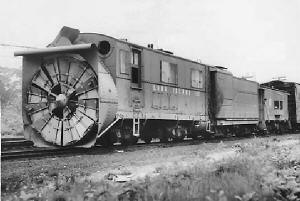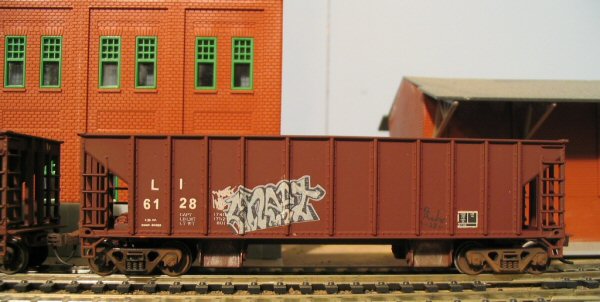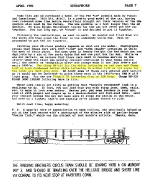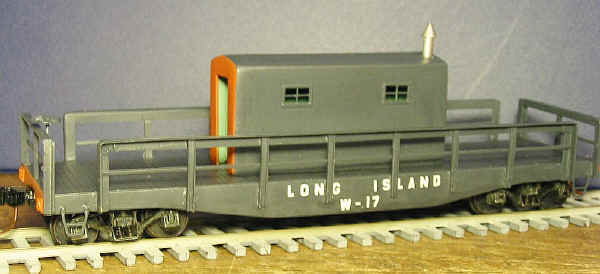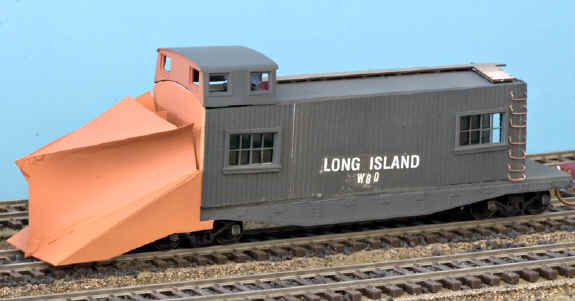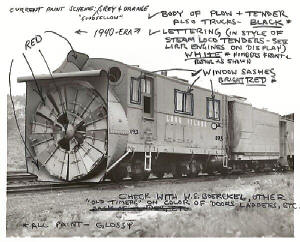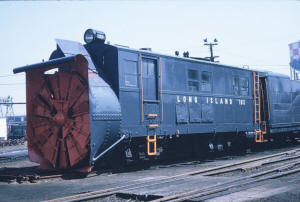|
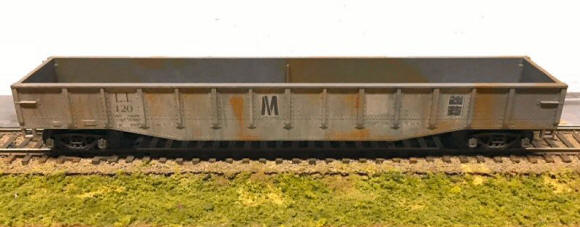 |
LIRR #120 MOW gondola c.1980+
Model/Photo: Al CastelliDefined by the AAR,
the large single panel COTS were optional and applied to new and rebuilt
cars from 1972 to July 1, 1974. On that date the two part COTS, with the
lub info, became mandatory with a deadline of 1979 for application to all
cars. This certainly places the car after 1979 and no need for the ACI
label. |
|
Modeling LIRR MOW
Operations
By Nicholas Kalis
Much has been
written about creating a sense of place for your layout, but far fewer
written words have appeared about how to achieve this goal. One concrete
method of creating a sense of place is to model maintenance of way
(MOW) cars on your layout. With the LIRR, this is particularly important
as this railroad owned virtually no revenue producing cars in recent
years. For LIRR modelers the tide has turned with three manufacturers -- F
& F, J.J.B. Custom
Products, and Hobby Images-- advertising MOW cars for sale.
The recent
introduction of several decorated MOW car sets in HO-scale invites
examining past and present LIRR MOW fleets. F & F Custom Trains of
Babylon, New York, has produced three different sets in the Long Island 's
1960s paint scheme to include three gondolas, a crane set, and a
caboose.[1] F & F's set, scheduled to be ready the second week in August
1994, was limited to 100 sets (three gondolas, boom and tender car). F & F
has decorated Bachmann's
Crane Car & Boom Tender (Item No. 46-1210-G4) as Crane number 172 and boom
car number 59. The crane and boom car are painted dark grey with orange
ends and black roofs. F& F has applied Dashing Dan logos with pedestal
on both. Glazing for windows are neither installed nor provided in my
sample.
The crane car and boom car sold for $60.00/set.
F&F's gondolas are
decaled as W4, W66, and W17, which are correct numbers for the 1960s paint
scheme applied. The gondolas, Model Die Casting's Roundhouse Products,
came assembled, decaled, weathered, and painted in
grey/orange. Cast metal underframes on F&F's gondolas were unpainted and
so must be painted by the modeler himself. F&F's weathering, mostly
consisting of rust, was less than convincing to this reviewer. As these
are hand-painted models, I would hope F&F's weathering will improve with
future production. F&F's gondolas would suffice those seeking to quickly
convey the LIRR spirit on their layout. F&F's painting of the gondolas
would not be sufficient to satisfy one seeking a museum-quality display
model. The caboose for F & F's MOW set will be available around Christmas
1994.
J.J.B. Custom Products of
16 Kent Place, Amityville, NY 11701 also offers Gondolas in various LIRR
paint schemes. Similarly, Hobby Images offers an outside braced wooden box
car Tuscan # 4054 and Grey # 489589, a 54 foot gondola decorated as either
number 112 or 120, and W88, a 10,000 gallon tank car, all decorated for
LIRR MOW service. As no samples of any of these products have yet reached
your author, I cannot comment on these models.
As welcome news for
HO-scale modelers, F&F Custom Trains is taking reservations for a possible
run of LI MOW vehicles (rubber-tired variety) decorated in their 1960s
paint scheme to be available around Christmas 1994.
As it appears only in their catalog, readers may be unaware that F&F
offers a rotary snow blower decorated for Long Island Railroad service
(Catalog Number FF099322, $45.00 plus $2.90 S & H).
How equipment enters MOW
service makes for an interesting story. There have been periods when
certain types of equipment became surplus either by law or by the advent
of more modern equipment. As streamline passenger
equipment appeared, surplus heavyweight cars were often turned into
employee bunk cars. In the late 1940s, as diesels replaced steam
locomotive, tenders were often salvaged to store water or fuel. It seems
the LIRR owned at least one example of each of the AAR classifications of
MOW equipment. |
